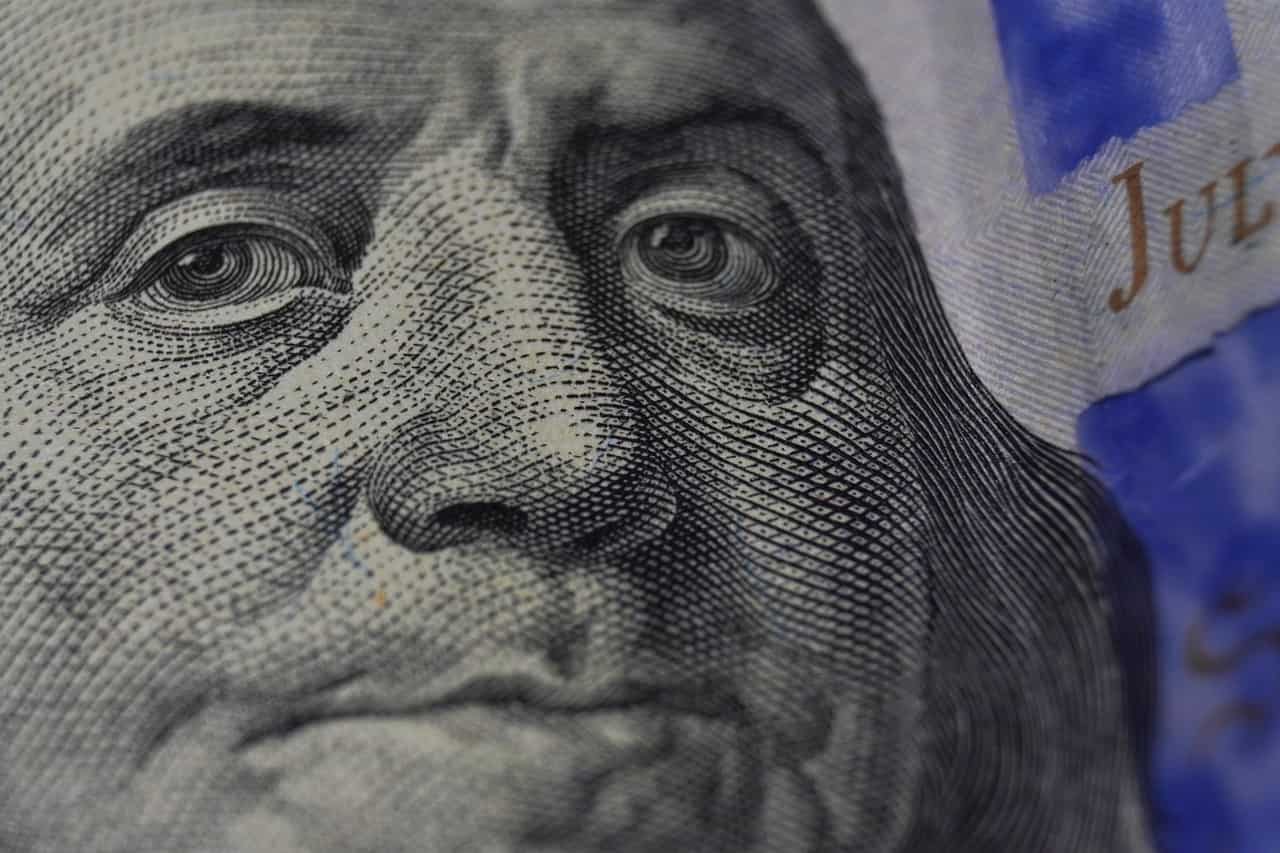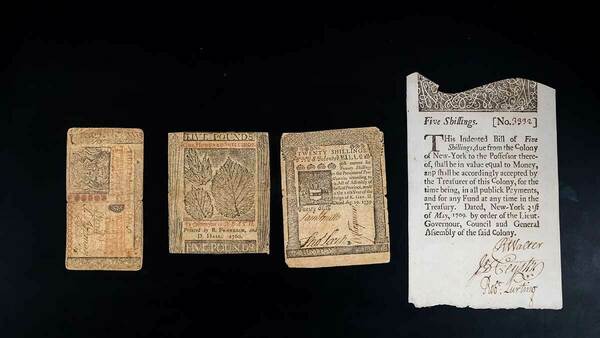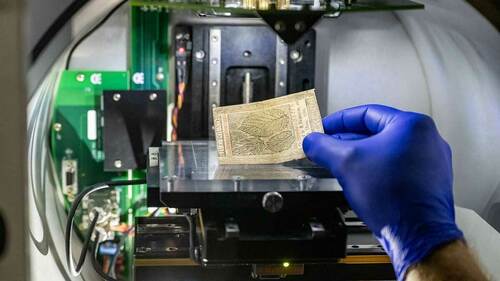
Between managing a printing shop, pioneering the development of the U.S. postal system, establishing the first lending library in America, and playing a critical role in laying the groundwork for the American Revolution, Franklin also somehow found time to invent an extensive array of devices.
The 18th-century Founding Father is credited with inventing the odometer (the instrument that measures the distance traveled by vehicles), glass armonica, the lightning rod, and bifocal eyeglasses, among other gizmos. But although his portrait is on the $100 bill, most Americans are unaware that Franklin was responsible for printing one of the first paper currency in the American colonies.
Franklin’s innovations in printing money were crucial for the fledgling American economy. However, his techniques have been largely lost through time. Now, researchers have used physics to reverse engineer Franklin’s work, revealing how he used secret techniques to prevent counterfeiting.
America’s first money
In the mid-18th century, the American colonies faced a shortage of circulating currency. The silver and gold coins from Britain rapidly drained away to pay for imported goods, leaving the Colonies with an inadequate money supply to develop their own economy.
During this time, barter was common, as were the various substitute foreign currencies, such as the Spanish pieces of eight and even the wampum, the clamshell currency of Native Americans.
In 1652, John Hull, a merchant residing in the Massachusetts Bay Colony, established the first colonial mint. It produced silver threepences, sixpences, and shillings adorned with pine tree symbols until it was compelled to shut down in 1684. The British authorities viewed the colony’s issuance of its own coins as a potentially dangerous manifestation of independence since the authority to mint coins was closely linked to sovereignty.
To address the challenge of compensating soldiers who returned from a failed campaign against the French in Canada in 1690, Massachusetts introduced bills of credit. These bills could be redeemed at a later date in gold and were recognized as legal tender for tax payments. Massachusetts thus became the first state since medieval China to introduce a paper currency.
The advantages of this innovation were obvious to Benjamin Franklin, who published a pamphlet in 1729 advocating for the broader adoption of paper money in the colonies. Franklin argued that such a move would also be beneficial to Britain’s interests, careful not to draw the crown’s suspicion and anger.

Inspired by Massachusetts’ initiative, the remaining colonies also began issuing their own paper currency, referred to as Colonial Scrip, denominated in pounds, shillings, and pence. Each American colony had its distinct form of currency, and the notes from one colony could be exchanged in others, although the exchange rates varied. These rates reflected the relative economic strength of each colony and the quantity of currency that had been put into circulation. Essentially, the colonies embraced a decentralized currency system with individual currencies, interlinked through varying exchange rates.
Throughout these developments, Ben Franklin’s contributions proved crucial. His printing business, along with his understanding of economics and finance, positioned him as a trusted figure in currency matters. As a result, Franklin became central in shaping the monetary policies and practices of the American colonies.
Franklin’s legacy in printing money extends beyond his involvement in the American colonies. Later in his life, he played a crucial role in establishing a national currency for the newly formed United States. As a delegate to the Continental Congress, Franklin was part of the committee responsible for designing and implementing the Continental currency, also known as “Continental dollars,” during the American Revolutionary War.
Ben Franklin against colonial counterfeiting

Franklin faced a significant obstacle in his pursuit of printing paper money: the problem of counterfeiting. In the Colonial period, paper money was a relatively new concept with no standardized bills. This lack of uniformity provided counterfeiters with an opportunity to pass off fake bills as genuine ones. Often, these counterfeit bills were introduced into circulation by the British government as a form of economic warfare.
“The artists they employed performed so well that immense quantities of these counterfeits which issued from the British government in New York, were circulated among the inhabitants of all the states, before the fraud was detected. This operated significantly in depreciating the whole mass,” Franklin wrote.
To combat this, Franklin implemented a range of security features that made his notes distinctive. To uncover these now long-lost techniques, researchers led by Khachatur Manukyan, an associate research professor in the Department of Physics and Astronomy at the University of Notre Dame in Indiana, spent seven years analyzing nearly 600 Colonial notes from the Hesburgh Libraries’ Rare Books and Special Collections.
These notes, spanning an 80-year period, were printed by Franklin’s network of printing shops, but also other printers — and this included counterfeit bills.
“To ensure the reliability of the notes, Franklin had to outsmart counterfeiters,” Manukyan said in a press release. “Unfortunately, the ledger where he recorded these printing decisions and methods has been lost to history. Using physics techniques, we have managed to partially restore what that record would have revealed.”
Manukyan and his team employed cutting-edge spectroscopic and imaging instruments housed in various Notre Dame research core facilities. These tools allowed them to closely examine the inks, paper, and fibers that made Franklin’s bills unique and difficult to replicate.
One of the most notable discoveries involved Franklin’s pigments. Researchers found that counterfeit bills contained unusually high quantities of calcium and phosphorus, elements that were only present in trace amounts in genuine bills.
Their analyses also revealed Franklin’s use of a special black dye made from graphite found in rock, distinguishing it from other pigments like “bone black” favored by both counterfeiters and printers outside Franklin’s network. Additionally, the team found evidence that Franklin incorporated colored silks in his paper, a technique often attributed to Zenas Marshall Crane, a paper manufacturer who introduced it in 1844.
Furthermore, the team discovered that Franklin’s network of printers added a translucent material identified as muscovite to their notes, giving them a unique appearance. Over time, the size of the muscovite crystals in the paper increased. Initially, Franklin likely introduced muscovite to enhance durability, but its deterrent effect on counterfeiters led to its continued use.
Working with rare and archival materials presented unique challenges for the physics lab. Manukyan highlighted the interdisciplinary nature of the project served and the value of collaboration.
“We were fortunate to have student researchers who shared an interest in both physics and history or art conservation. The research facilities and the Rare Books and Special Collections team were exceptional partners. Without this uncommon collaboration across disciplines, our groundbreaking discoveries would not have been possible,” said Manukyan.
The study was published in the Proceedings of the National Academy of Sciences.


